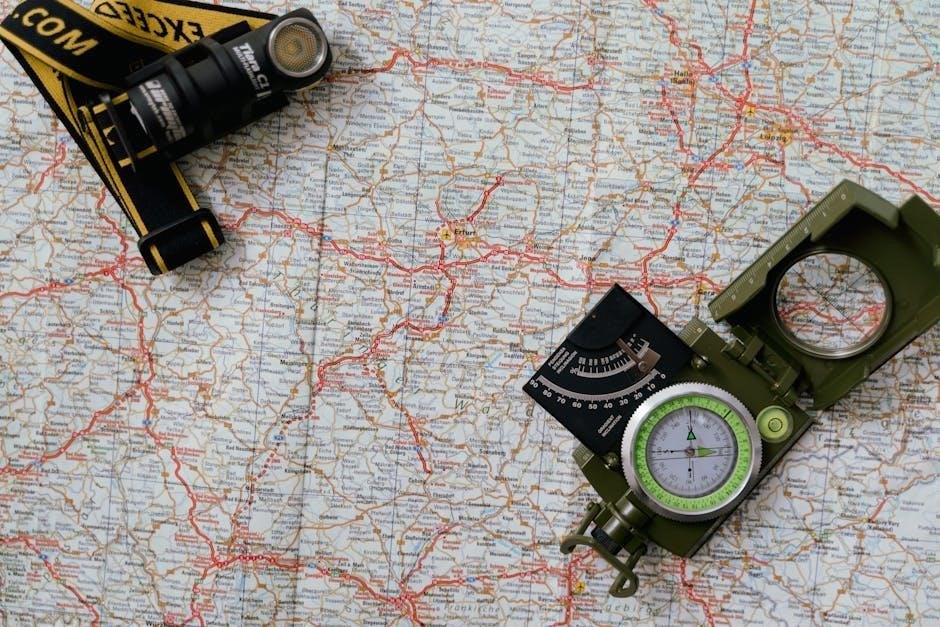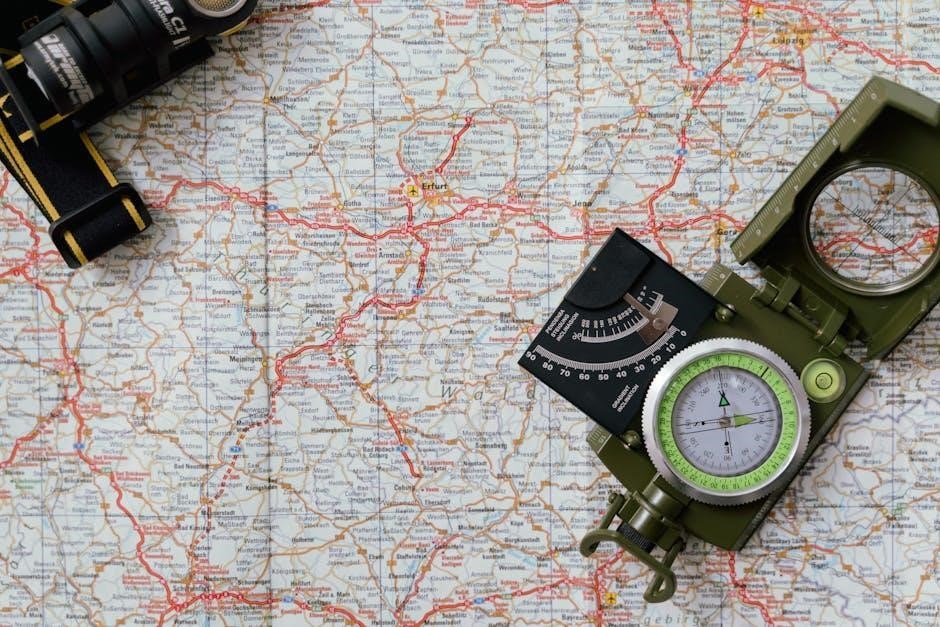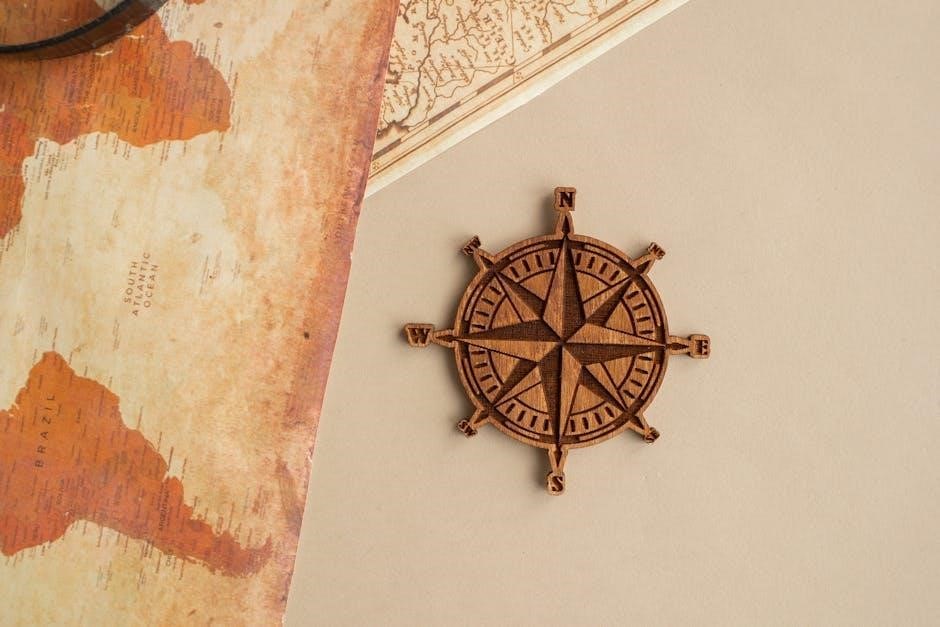
Welcome to your AQA GCSE Geography Revision Guide, designed to help you excel in your exams. This guide covers both Physical and Human Geography, ensuring comprehensive preparation for all topics. It includes clear study notes, examples, and case studies to aid understanding. The guide also features exam-style questions to familiarize you with the exam format.
- Key areas like rivers, coasts, ecosystems, and climate change are thoroughly explained.
- Human Geography topics such as urban issues and population are also included.
- Revision tips and strategies are provided to help you stay organized and focused.
By using this guide, you can identify your strengths and weaknesses, allowing targeted revision. Combine it with past papers and fieldwork skills for the best results. Start your journey to exam success today!

Physical Geography
Physical Geography focuses on the natural features of the Earth, including landscapes, processes, and systems. The AQA GCSE Geography revision guide covers key topics such as rivers, coasts, ecosystems, and climate change. These sections provide detailed explanations of how natural processes shape our environment. For rivers, you’ll explore processes like erosion, transportation, and deposition, as well as river landforms and management strategies. Coasts examine coastal erosion, deposition, and the impacts of human activity. Ecosystems delve into biomes, conservation, and the balance of nature. Climate change discussions include causes, effects, and global responses. The guide offers clear diagrams, case studies, and exam-style questions to help you master these topics. Use past papers to practice and focus on understanding the processes and their real-world applications. This section is essential for building a strong foundation in Physical Geography for your exams.
2.1 Rivers
Rivers are a fundamental component of Physical Geography, playing a crucial role in shaping landscapes and supporting life. The AQA GCSE Geography revision guide dedicates a significant section to the study of rivers, ensuring students gain a deep understanding of their processes, landforms, and management strategies. Rivers are dynamic systems that flow from their source to their mouth, carving out valleys and creating a variety of landforms along the way. Understanding the lifecycle of a river, from youthful to mature stages, is essential for analyzing its impact on the environment and human activities.

Key Processes in Rivers
The study of rivers revolves around three primary processes: erosion, transportation, and deposition. Erosion refers to the wearing away of rock and soil, which can occur through hydraulic action, abrasion, or attrition. Transportation involves the movement of eroded materials, such as sand, silt, and pebbles, downstream. Deposition occurs when these materials are dropped, often at the mouth of the river or in floodplains. These processes shape the river’s course and surrounding landscape, creating distinctive features such as waterfalls, meanders, and deltas.
River Landforms
The revision guide highlights key river landforms, including:
- Waterfalls: Formed where a river flows over a steep drop in the landscape, often due to differences in rock type. Victoria Falls in Zambia is a notable example.
- Meanders: S-shaped bends in a river caused by faster current eroding the outer bank and slower water depositing sediment on the inner bank.
- Oxbow Lakes: Created when a meander is cut off from the main river due to sedimentation and erosion.
- Deltas: Triangular deposits of sediment at the mouth of a river, such as the Ganges-Brahmaputra Delta.

River Management Strategies
The guide also explores how humans interact with rivers, focusing on management strategies to mitigate flooding, improve navigation, and enhance biodiversity. Hard engineering solutions, such as dams and levees, are contrasted with soft engineering approaches, like wetland restoration and afforestation. Case studies, such as the Mississippi River in the USA and the Yellow River in China, illustrate the challenges and successes of river management.
Revision Tips for Rivers
To excel in this topic, students should:
- Memorize key terms and processes using flashcards or mind maps.
- Practice analyzing river profiles and cross-sections to understand changes along a river’s course.
- Review case studies to exemplify landforms and management techniques.
- Engage with past papers to familiarize yourself with exam-style questions.
By mastering the concepts of rivers, students will be well-prepared to tackle related questions in their AQA GCSE Geography exams. This section of the revision guide is designed to build confidence and deepen understanding of these vital natural systems.

2.2 Coasts
Coasts are dynamic and constantly changing environments that play a vital role in shaping our planet. The AQA GCSE Geography revision guide provides a comprehensive overview of coastal processes, landforms, and management strategies, equipping students with the knowledge needed to excel in this topic. Coasts are the interface between land and sea, where a variety of natural processes interact to create unique landscapes. Understanding these processes and their impacts is crucial for analyzing human interaction with coastal environments.
Key Coastal Processes
The study of coasts revolves around three primary processes: erosion, transportation, and deposition. These processes are driven by the relentless action of waves, tides, and currents. Erosion involves the wearing away of the coastline, which can occur through mechanisms such as hydraulic action, abrasion, and attrition. Transportation refers to the movement of eroded material along the coast, often carried by longshore currents. Deposition occurs when sediment is dropped, typically in areas where the energy of the waves decreases, such as in bays or behind barriers. These processes shape the coastline and create a variety of landforms.
Major Coastal Landforms
The revision guide highlights several key coastal landforms, including:
- Cliffs: Steep rock faces formed through the erosional action of waves. Cliffs are further eroded by processes such as weathering and landslides.
- Beaches: Accumulations of sand, shingle, or pebbles deposited along the shoreline. Beaches act as natural barriers against wave energy.
- Bays: Indentations in the coastline where the sea is partially enclosed, often forming calm and sheltered environments.
- Headlands: Prominent rocky outcrops that jut out into the sea, exposed to the full force of waves.
- Deltas: Deposits of sediment at the mouth of a river, creating fertile and ecologically rich environments.
Coastal Management Strategies
Coastal management involves balancing the needs of different stakeholders while protecting both the environment and human settlements. The revision guide explores two main approaches: hard engineering and soft engineering. Hard engineering solutions include structures such as seawalls, breakwaters, and groynes. These are designed to control or prevent natural processes, often providing immediate protection but potentially disrupting neighboring ecosystems. Soft engineering, on the other hand, works with natural processes, focusing on beach nourishment, dune restoration, and managed retreat. Each strategy has its advantages and challenges, as illustrated by case studies from around the world, such as the Thames Barrier in London and the sand dune restoration in the Netherlands.
Case Studies and Examples
To reinforce understanding, the revision guide incorporates real-world examples of coastal processes and management. For instance, the erosion of cliffs at locations like the White Cliffs of Dover demonstrates the impact of wave action and weathering. Similarly, the formation of beaches in tropical destinations such as the Maldives highlights the role of deposition in creating iconic landscapes. These examples allow students to visualize and apply their knowledge effectively.
Revision Tips for Coasts
To excel in this topic, students should:
- Use diagrams to illustrate coastal processes and landforms, aiding memory retention.
- Practice analyzing case studies to understand the effectiveness of different management strategies.
- Review past papers to familiarize yourself with exam-style questions, such as comparing hard and soft engineering techniques.
- Engage with fieldwork skills, such as measuring wave height and longshore drift, to gain practical insights.
By mastering the concepts of coasts, students will be well-prepared to tackle related questions in their AQA GCSE Geography exams. This section of the revision guide is designed to build confidence and deepen understanding of these dynamic and ecologically significant environments;
2.3 Ecosystems
Ecosystems are complex communities of living organisms (biotic factors) interacting with their physical environment (abiotic factors). The AQA GCSE Geography revision guide emphasizes the importance of understanding ecosystems, their structure, and the challenges they face due to human activity. Ecosystems provide essential services, including air and water purification, food production, and carbon storage, making them vital for human survival and planetary health.
Key Components of Ecosystems
Ecosystems are composed of two main components: biotic and abiotic factors. Biotic factors include producers (plants and algae), consumers (herbivores, carnivores, and omnivores), and decomposers (fungi and bacteria). Abiotic factors, such as light, temperature, water, and soil, influence the functioning of ecosystems. The revision guide highlights the interconnectedness of these components, demonstrating how changes in one part of an ecosystem can have ripple effects throughout the entire system.

Structure of Ecosystems
Ecosystems are structured in a hierarchy of layers, starting from individual organisms, populations, communities, and finally the ecosystem itself. The revision guide explains how energy flows through ecosystems via food chains and food webs. Producers form the base of these chains, converting sunlight into energy through photosynthesis. Consumers then transfer energy from one trophic level to the next, with only about 10% of energy being passed on at each stage due to the “10% rule.” This inefficiency explains why there are fewer apex predators than primary producers in most ecosystems.
Ecosystem Services
Ecosystems provide four main types of services:
- Provisioning Services: These include tangible resources such as food, freshwater, and timber. For example, forests provide wood for construction and fuel.
- Regulating Services: Ecosystems regulate natural processes like climate, water cycles, and soil erosion. Wetlands, for instance, act as natural flood defenses.
- Cultural Services: Ecosystems offer recreational, spiritual, and aesthetic value. National parks and coral reefs attract tourists, boosting local economies.
- Supporting Services: These underpin all other services, including nutrient cycling, pollination, and soil formation. Without these, ecosystems would collapse.

Threats to Ecosystems

Ecosystems face numerous threats, primarily due to human activities. Deforestation, driven by agriculture, urbanization, and logging, has devastated habitats like the Amazon rainforest. Climate change alters temperature and precipitation patterns, disrupting species distributions and extinction risks. Pollution from industrial waste and plastic contaminates ecosystems, harming wildlife and human health. Overfishing and unsustainable practices further degrade marine ecosystems, threatening biodiversity.
Solutions and Management
The revision guide explores strategies to mitigate these threats. Sustainable practices, such as reforestation and organic farming, can reduce ecosystem degradation. Protected areas like nature reserves and marine parks safeguard vulnerable species and habitats. Restoration projects, such as wetland reconstruction, aim to revive damaged ecosystems. Education and policy changes are also critical, encouraging individuals and governments to prioritize conservation.
Case Studies
The AQA GCSE Geography revision guide uses case studies to illustrate ecosystem dynamics. For example:
- The Amazon Rainforest, often called the “lungs of the Earth,” demonstrates the importance of tropical ecosystems in carbon sequestration and biodiversity.
- The Great Barrier Reef highlights the impact of climate change on marine ecosystems, with coral bleaching threatening this UNESCO World Heritage Site.
Revision Tips
To succeed in this topic, students should:
- Use diagrams to illustrate energy flow and food webs.
- Practice essay questions comparing ecosystem services and threats.
- Engage with case studies to apply theoretical knowledge to real-world examples.
Understanding ecosystems is vital for addressing global challenges like biodiversity loss and climate change. The AQA GCSE Geography revision guide provides a detailed exploration of this topic, equipping students with the knowledge and skills needed to excel in their exams and contribute to a more sustainable future.

2.4 Climate Change
Climate change is one of the most pressing global issues of the 21st century, and it is a key topic in the AQA GCSE Geography curriculum. The revision guide provides a comprehensive overview of the causes, impacts, and potential solutions to climate change, equipping students with the knowledge needed to understand this complex and dynamic subject.
What is Climate Change?
Climate change refers to significant, long-term alterations in global temperatures and weather patterns. It is distinct from short-term weather fluctuations. The Earth’s climate has always gone through natural cycles of warming and cooling, but recent changes are largely driven by human activity. The AQA GCSE Geography revision guide emphasizes the distinction between natural climate variability and anthropogenic (human-induced) climate change.
Causes of Climate Change
The primary cause of modern climate change is the increasing levels of greenhouse gases in the Earth’s atmosphere, such as carbon dioxide (CO2), methane (CH4), and nitrous oxide (N2O). These gases trap heat from the sun, leading to global warming. The main human activities responsible for these emissions include:
- Burning of fossil fuels: Coal, oil, and gas combustion for energy releases large amounts of CO2.
- Deforestation: The clearance of forests for agriculture and urbanization reduces the ability of trees to absorb CO2.
- Industrial processes: Cement production, steel manufacturing, and other industries emit significant amounts of greenhouse gases.
- Agriculture: Livestock, especially ruminant animals like cows, produce methane as part of their digestion process.

Impacts of Climate Change
The effects of climate change are widespread and varied. Rising global temperatures are causing melting of polar ice caps and glaciers, leading to sea-level rise. This, in turn, increases the risk of coastal flooding and erosion. The AQA GCSE Geography revision guide highlights the following key impacts:
- Extreme weather events: Climate change is linked to an increase in frequency and severity of heatwaves, hurricanes, and heavy rainfall events.
- Changes in precipitation patterns: Some regions are experiencing droughts, while others face unprecedented rainfall and flooding.
- Biodiversity loss: Many species are unable to adapt to rapid changes in their habitats, leading to extinction.
- Food insecurity: Climate change disrupts agriculture, threatening food supplies and livelihoods, particularly in vulnerable communities.
Adapting to and Mitigating Climate Change
The revision guide explores the two main approaches to addressing climate change: adaptation and mitigation.
- Mitigation: This involves reducing greenhouse gas emissions to limit the extent of climate change. Strategies include transitioning to renewable energy sources (e.g., wind, solar, and hydropower), increasing energy efficiency, and implementing carbon capture and storage technologies.
- Adaptation: This focuses on reducing the impacts of climate change that are already being felt. Examples include building sea walls to protect coastal communities, developing climate-resilient crops, and improving early warning systems for extreme weather events.
International Responses
Global cooperation is essential in addressing climate change. The AQA GCSE Geography revision guide highlights key international agreements, such as the Paris Agreement, which aims to limit global warming to well below 2°C and pursue efforts to limit it to 1.5°C above pre-industrial levels. Countries have also made Nationally Determined Contributions (NDCs) to outline their plans for reducing emissions and adapting to climate impacts.
Case Studies
The revision guide uses real-world examples to illustrate the effects of climate change and responses to it. For instance:
- The Arctic is experiencing rapid warming, with melting sea ice threatening polar bears and other species.
- Small island nations, such as the Maldives, are at risk of disappearing due to rising sea levels.
- Developing countries in Sub-Saharan Africa are particularly vulnerable to climate-related droughts and famines.
Revision Tips
To excel in this topic, students should:
- Focus on understanding the causes and effects of climate change at different scales (local, national, and global).
- Use diagrams to illustrate the greenhouse effect and carbon cycles.
- Practice essay questions on balancing the pros and cons of different strategies to address climate change.
- Engage with case studies to develop real-world examples for exam answers.
Climate change is a critical area of study in AQA GCSE Geography, requiring students to think critically about both the science behind the issue and the social, economic, and political responses to it. By using the revision guide effectively, students can gain a deep understanding of this vital topic and prepare thoroughly for their exams.